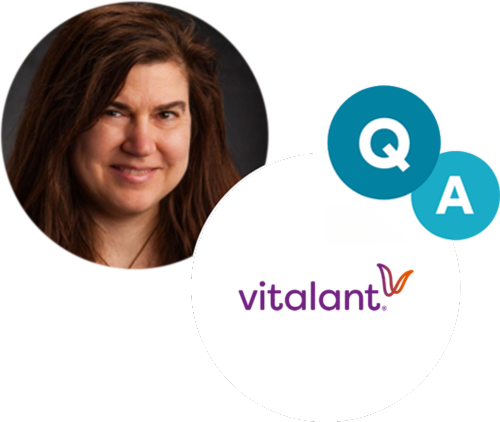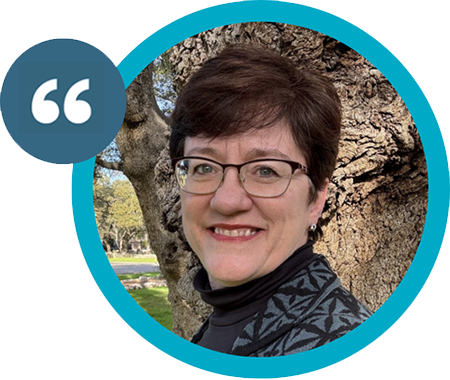

I have been in life sciences my entire career and have always been drawn to new and emerging markets – clinically and commercially. I started at the Dana-Farber Cancer Institute when bone marrow transplant was being considered for high-risk solid tumor indications. I began consulting to work on new product commercialization strategy and was involved in some of the hottest category-creating drugs, including Gleevec and Keytruda. I worked on monoclonal antibodies as their indications expanded from oncology to autoimmune diseases. Now, I am working in cell and gene therapy as some of our cell therapies are, similarly, expanding from oncology indications into treatment for autoimmune disease patients. Building new services and new treatment options for patients is a passion for me. Vitalant offered the opportunity to contribute to the development of the cell and gene therapy market in a way that overcomes barriers to patient access in their communities.
Vitalant is already having an important effect in this space, and I see its role growing in influence and in impact. Vitalant has a community health care infrastructure network that can be leveraged to connect therapeutic developers, hospitals and patients to support optimal delivery of care. Because Vitalant has served communities' and hospitals' needs for 80 years, we have established our reliability as a clinical services partner. We work with hospitals to collect, process and deliver therapeutic products; we process, freeze and store them; and we take responsibility for getting them tested to ensure patient safety. And, because our infrastructure is already in place, we can offer to provide a full set of services for hospitals just starting out in this space or we can provide backup services for hospitals who have a single infrastructure gap or capacity limitation.
We also have a long history as an AABB-accredited service. The physical and personnel infrastructure we offer, combined with our critical accreditations, can serve as the connective tissue between hospitals and therapeutic developers that allows community hospitals who are prepared clinically to focus on making it feasible for patients to receive cell and gene therapy in their community. It allows the hospitals and clinicians to focus on taking care of the patients and the developer to focus on the product requirements. Partnering with Vitalant is often an easy choice for developers because we offer efficiency, flexibility, expertise and scalability for small to large companies with our single contract access to all sites and services and our unified Quality Management System. This agility and willingness to customize services within this framework makes Vitalant a go-to for hospitals too.
As the number of therapies and indications grow and, especially as they target earlier line treatment and autoimmune disease patients, Vitalant's connective tissue in the community reduces the logistical and technical barriers to growing the number of patients who can receive cell and gene therapies. This allows hospitals and clinicians to focus on care delivery and allows developers to extend the benefit of their development efforts to more patients.

We are creating an extensive and growing menu of service offerings across our major hubs throughout the country - collections, processing and cryopreservation, storage and delivery of a finished product to the bedside. We are also talking to a few pilot sites about providing other clinical services, whether in hospital or in our facilities. Being able to facilitate treatment across our footprint gives us hope for the patients and families in our communities.
We are focused on a strategic geographic expansion of our collections capabilities. For example, we have a therapeutic apheresis service that also provides apheresis collections capabilities for cell and gene therapies inside a hospital or other clinical setting. We also have cell collection capabilities in fixed sites that Vitalant has built over decades, and we have teams of mobile nurses who are flexible and can travel to a preferred site to complete collections when and where needed. Vitalant's footprint in 28 states and our ability to mobilize collections staff quickly and efficiently under our unified QMS, allows us to provide agile support for patients to receive therapy in their community - if we aren't already where you need us, we can get there pretty quickly.
While all of these are important, I am passionate about working with our partners to drive the level of CGT care for patients in their local communities to unprecedented levels. The details are not yet ready for sharing, but we are doing everything we can to support safely treating cell and gene therapy patients in their community - reducing cost to patients' families and allowing them - patients, families, and caregivers - to continue with their lives with minimal interruption to their routine.
There are so many lessons we can leverage from that experience: managing through the unexpected, creating structure and quality systems that allow for both rigor and flexibility to manage and mitigate risk, and developing tightly integrated community and hospital infrastructure to deliver care. I also think we have a sense of what to look out for. The history through the AIDs epidemic is a story of “gotchas” and missed opportunities. In some cases, we overengineered restrictions out of concern for patients and a lack of knowledge - we boxed ourselves into overly restrictive thought processes. In others, we focused on addressing a specific problem rather than thinking about broader frameworks. As we develop new cell and gene therapies, we face those same risks again. Looking back at some of the decisions made that introduced challenges for us during the AIDS crisis gives us a template to work from in thinking about best practices and how we can constantly optimize and learn from our professional blood banking community and the health care providers who see these patients and therapies up close.
Some of this also extends to how we work with regulators. The regulatory space in the US is being heavily influenced by both pharmaceutical and blood standards, when these products need to have a standard all to themselves, creating relevant guardbands, but allowing for flexibility in these living therapies.

Donors and patients are familiar with our facilities. We're as comfortable interacting and supporting them as we are supporting hospitals and clinicians. That creates an opportunity for us to be a trusted partner to all of those parties. Our biggest challenges lie in expansion of clinical expertise in cell and gene therapy, connectivity of systems across the different locations and components of care, and the multitude of systems in development to provide support for each specific therapy and company. Getting through this wave of technology creation to a point of consolidation will be a significant challenge. Looking forward, we will need to consolidate to a limited number of systems that will allow data to move freely and allow us to maximize our learning from the data that has been collected.
There are huge opportunities for technology to shape this space. In fact, I think technology innovation is critical to its survival. Short term, I think the potential is here and now for the most fundamental changes in how we do work - through automation and closed systems. Therapy production remains fussy, with many opportunities for deviations and inconsistencies. We're all banking on AI to make a difference, but we have to get our systems automated and operating efficiently before AI can have an impact consistent with its promise. This will, in and of itself, reduce errors, reduce variability and allow for higher throughput rates. A big win overall.

AABB's voice and breadth of visibility to the range of challenges and potential solutions for cell and gene therapy regulatory and policy considerations is especially meaningful. Advocating for best practices for patients is a unique role for AABB - pushing itself and its members for the highest achievable standards to streamline accreditation and shape policy. Optimizing implementation and thinking through the challenges we've faced in previous challenging environments will enable organizations with roots in blood banking to offer creative solutions to cell and gene therapy products.
Biotherapies are highly regulated today. What is interesting is how the agency is monitoring the space - not just each specific drug - and adjusting the regulations as new information is collected and new outcomes are discussed. We are leveraging multiple strategies to help us meet the constant and ever-changing regulatory environment:
We are also evolving our practices in data collection - collecting data required to be compliant, but taking the extra step of reviewing it for information and insight about process and procedure optimization and efficiency. That sometimes means running a few extra tests and performing a global analysis on process and outcomes data to evaluate and shape the rationale for new procedures. We're also looking at cost drivers in our system to understand where we can focus our efforts on change in ways that drive costs down. As we evolve, we end up focusing on different questions and targets within our operation. These exercises give us the opportunity to constantly refine what we do and how we do it.

Biotherapies / advanced therapies offer an opportunity to transform health outcomes and create access to potential cures at an unprecedented scope. Fulfilling that promise will require unmatched levels of collaboration and partnership committed to thinking of new ways to get work done. We need to partner at levels never seen before to meet the speed, complexity and urgency to bring potential cures to millions of people. At Vitalant, we see this as a vital cause, requiring us to move strategically, at a pace not seen before to meet the challenge of the promise of a possible cure for patients in our communities. Let's not lose sight of how we all need to work together to make it successful - for us, for patients, and for our patients and families to come.
For further information on CellSource sponsorship please see AABB's Media Kit page or email businessdevelopment@aabb.org to discuss upcoming availability.

Keep abreast of what's happening in the field of biotherapies with CellSource - AABB's monthly update on the latest biotherapies news.